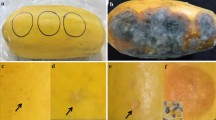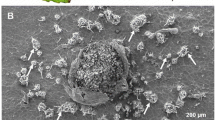Summary
The cankerous disease of guava (Psidium guajava L.) exhibiting characteristic spots and malformations is prevalent in Mysore. It is associated with two fungiColletotrichum psidii Curzi andPestalotia psidii Pat.
Colletotrichum psidii developed a perithecial stage in pure culture for the first time in India. The perithecia are globular, dark coloured, aparaphysate. Asci are numerous, hyaline and the ascospores are 8 in number, unicellular and granular. This stage corresponds closely toGlomerella psidii (Del.) Sheld.
Colletotrichum psidii infected the fruits of apple, chilly, lemon, papaya, plantain, mango and tomato and not brinjal and French bean.Pestalotia psidii did not infect any of these hosts. Both the fungi infected the injured fruits and leaves of guava.
Colletotrichum psidii is a general parasite whilePestalotia psidii is specialised to guava.
Three or four sprayings with 1% Bordeaux mixture or with lime sulphur solution 1:25 done at intervals of 15 days at an early stage of infection controls the spread of the fungi.
Similar content being viewed by others
Literature cited
Curzi, M. “De novis Eumycetibus. (Concerning new Eumycetes.),”Atti Ist. Bot. R. Univ. di Pavia, 1927,3, 203–08, Abst.Rev. App. Mycol., 1928,7, 744.
Dey, P. K. “A disease of guava fruits in the United Provinces,”Int. Bull. Plant Protection, 1934,8, 30 M.
Hopkins, J. C. F. “A descriptive list of plant diseases in Southern Rhodesia and list of bacteria and fungi,”Mem. Dept. Agric., 1950, No. 2, 57.
Leach, R. “Insect injury simulating fungal attack on plants. A stem canker, an angular spot, a fruit scab and a fruit rot of mangoes caused byHelopeltis bergrothi Reut. (Capsidae),”Ann. Appl. Biol., 1935,22, 525–37.
Mehta, P. R. “Observations on new and known diseases of crop plants of the Uttar Pradesh,”Plant Protection Bull., 1951,3, 1, 11–12 (Ministry of Food & Agric, Govt. of India).
Narasimhan, M. J. “Report of work done in the Mycological Section” InAnn. Repts. Mys. Agric. Dept., 1929–30, 1931, 24; 1936%#x2013;37, 1938, 172; 1938–39, 1940, 96–97; 1939–40, 1941 255.
Ocfemia, G. O. “Notes on some economic plant diseases new in the Philippine Islands. II.”Phlipp. Agric., 1931, 19.
Patel, M. K., M. N. Kamat, and G. M. Hingorani “Pestalotiapsidii Pat. on guava,”Indian Phytopathology, 1950, III,2, 165–76.
Shear, C. L., and Anna K. Wood “Ascogenous forms ofGlœosporium and Colletotrichum,”Bot. Gaz., 1907,43, 259–66.
Venkatarayan, S.V. “Report of work done in the Mycological Section,”In Admn. Rept. Mys. Agric. Dept., 1935–36, 1937, 53.
Author information
Authors and Affiliations
Additional information
Communicated by Prof. L. Narayana Rao,f.a.sc.
The author is thankful to Sri. S. V. Venkatarayan, Plant Pathologist, for his interest and helpful criticism in the course of this work.
Rights and permissions
About this article
Cite this article
Venkatakrishniah, N.S. Glomerella psidii (Del.) sheld. andPestalotia psidii Pat. Associated with a cankerous disease of guava. Proc. Indian Acad. Sci. 36, 129–134 (1952). https://doi.org/10.1007/BF03050440
Received:
Issue Date:
DOI: https://doi.org/10.1007/BF03050440




